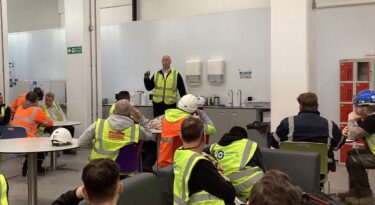Skills gap or skills gulf?
According to the international built assets consultants, Arcadis, British construction must recruit over 400,000 people each and every year between now and 2021 equivalent to one worker every 77 seconds.
In the time it takes you to read this I am hoping that three people will have been employed; if not we may start to see a more of a skills gulf than a skills gap.
Untapped sources
Where are these workers going to come from? They certainly dont grow on trees. I believe we can focus on some untapped sources : our young people, and the pool of talent available within former Armed Services personnel, are two ; I also believe we can embrace the opportunities of advances in technology to address our longer-term skills challenges in a different way.
In the summer I was lucky enough to spend some time at one of Wates Building Futures programmes in Coventry. This is a programme which has been designed to bridge the skills gap between our industry and the unemployed, particularly young people,
I was blown away by the attitude of the group of young adults we were taking through the programme. Each and every one of them was bursting with enthusiasm to get into work. Some had been unemployed for up to three years and others had struggled to find permanent work.
But through Building Futures, Wates is attempting to put them with the right people, help them to gain vocational training and valuable on-the-job experience. If we could scale up projects like this across the industry we could be developing thousands of skilled workers with essential life skills.
I also joined a group of Armed Forces leavers in Aldershot. With around 1.5 million people unemployed in the UK and 14,000 servicemen and women leaving the Armed Forces every year, it struck me that by tapping into the stream of ex servicemen and servicewomen leaving the forces, we could go at least some way towards shrinking the potential numbers gulf.
In a former life I was a diver in the Royal Navy and I know from first hand experience that Armed Forces leavers are a group of people with fantastic potential. While some would be joining us ‘raw’ – without the key vocational skills we need, they already have the life skills our industry needs: theyre bursting with positivity; displaying a can-do attitude, matched with confidence, discipline and reliability.
Earlier this year Wates signed up to Buildforce – a nationwide initiative to provide Armed Forces leavers with the right opportunities to our industry. Buildforce works closely with UK contractors to help individuals leaving the Forces up-skill and prepare for a planned and smooth career shift into the built environment.
Ambassadors for our industry
Historically, our industry isnt everyones first choice for employment. Much of this has to do with external perception, how we as an industry community often portray ourselves in public. We are all ambassadors and have to work on our presentation! When I met with both our Building Futures candidates and the Armed Forces leavers, I did my best to make our industry look interesting and most importantly progressive. It wasnt difficult; I just talked about its many and varied roles, challenging but exciting environments, rewarding work and benefits to the wider society we live in.
Robotic revolution?
Reducing the skills gap will take more than a re-think of training however. In the long term the industry must do more to advance our use of smart technology; experiment and be bold with the use of robotics; and get much better at how we take advantage of Modular Construction techniques. If we can introduce methods such as these and get them right, we can reduce the amount of people we will actually need.
For me as a health and safety professional, option two is my preferred one; fewer people mean fewer accidents. So bring on the robotic revolution!
However, realistically if we are to shrink our impending skills gulf to a more manageable skills gap, right now both options need to be pursued with equal vigour.




